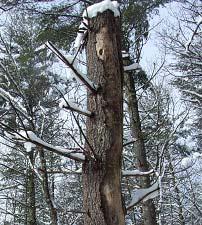Hemlock Trail

Map: Open Street Map detail
Map: NRPC Map detail
Length: 0.8 miles
Identification: Yellow blazes
Difficulty: Walking: Moderate
Identification: Yellow blazes
Difficulty: Walking: Moderate
XC skiing: Difficult
Mountain biking: Mostly moderate,
difficult in places.
The Hemlock Trail is the newest trail in JER. It was opened in 2000 after a selective forest harvest was completed on the Arnold section of the reservation. The trail leads the hiker through an interesting variety of forest habitats. It rises from Hammond Brook at an elevation 320 feet above sea level to the Bicentennial Trail at elevation 510’. A loop walk of 1.5 miles is possible by ascending the Hemlock Trail and returning down the Bicentennial Trail. For XC skiing, the Hemlock Trail provides a little more manageable (enjoyable) route than the Bicentennial Trail section it parallels.
Log: Start your walk at Post 1 on the Hammond Brook Trail by crossing the bridge over Hammond Brook. The brook, formed in the ponds on Mack Hill, drains a watershed that is mostly wooded. As a result, it has some flow in all but the driest seasons. In springtime, note the wildflowers close to the brook as you make your crossing. At 600’ and 1,000’ up the trail, skidder roads leave the trail. Keep your eyes open for the yellow blazes marking the trail.
At .4 miles a larger opening was created to encourage understory to return as forage and shelter for wildlife. Cutting in this area is a step in the ACC property management plan. Trees for cutting were selected by Forester Charles Koch to: 1) encourage long-term development of a higher-grade forest, 2) improve the forest habitat, and 3) to produce a small amount of revenue for use in land protection. The blue marks on the trees or stumps are those of the forester and not trail signs. During logging, treetops and limbs were crushed as the skidder moved saw logs to the log landing. As the slash decomposes, nutrients will be returned to the soil and the forest. Unlike a landowner who may clear for profit only or for a development, the ACC is managing for the long haul. Hence, you will see many large trees remaining to grow another 20 to 50 years, trees that would have been cut if profit were the sole motive. Another part of the ACC management program is an effort to leave snags* as sources of food and shelter for small mammals and birds.
At .5 miles the forest changes from predominantly pine and hemlock to one of maple, beech and oak. This indicates different historic cutting practices, either by different owners or the same owner with different needs. Continue straight ahead skirting a small vernal pool. Pools like this are important forest features which are counted upon by many amphibians for breeding even though there may only be water in the depression a few months of the year. The advantage of vernal pools is that they don’t support fish that would otherwise eat the amphibian eggs and hatchlings. The trail rises to its high point at 525 feet above sea level. Many broken pieces of the underlying ledge dotted with erratics mark this area. Mountain laurel, mosses and lichens are prominent in this dry setting as the trail jogs around two large erratics.
At .66 miles begin a descent to meet the Bicentennial Trail at Post 23. To the left (north) it is .8 miles to PMEC. To the right (south) it is a mile along the Bicentennial Trail to Austin Road.
*A snag is a decaying tree trunk. It becomes a source of food and shelter for many animals and birds. First, as decay sets in, insects and grubs move into the bark and wood. These are food for birds such as woodpeckers. In a few years a cavity started by a grub-searching woodpecker grows by decay or further pecking until it becomes a nest cavity for a small bird, perhaps a chickadee. Larger birds follow. Then squirrels may be the next apartment dweller before an owl takes over. In all this time the old trunk continues to decay until one night it succumbs and topples to the forest floor to return its nutrients to the earth.






